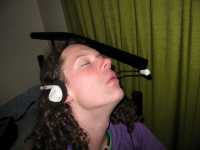Author Interviews, Obstructive Sleep Apnea / 22.10.2018
Obstructive Sleep Apnea: Short Apneas Linked To Increased Mortality
MedicalResearch.com Interview with:
 Matthew P Butler, PhD
Assistant Professor, Oregon Institute of Occupational Health Sciences
Assistant Professor, Department of Behavioral Neuroscience
Oregon Health & Science University
Portland, OR 97239
MedicalResearch.com: What is the background for this study? What are the main findings?
Response: Obstructive sleep apnea (OSA) is associated with heart disease and mortality, but how OSA does this is not well understood. We are therefore looking for sub-phenotypes within OSA that will help us predict who is at greatest risk.
Current diagnosis of OSA is made on the basis of the apnea-hypopnea index (AHI – the number of respiratory events per hour of sleep). But the AHI is not a very good predictor of future mortality.
We tested the hypothesis that the duration of events (how long the breathing interruptions are) would predict risk. We found that those with the shortest breathing interruptions had the highest risk of dying, after accounting for other conditions like age, gender, race, and smoking status. (more…)
Matthew P Butler, PhD
Assistant Professor, Oregon Institute of Occupational Health Sciences
Assistant Professor, Department of Behavioral Neuroscience
Oregon Health & Science University
Portland, OR 97239
MedicalResearch.com: What is the background for this study? What are the main findings?
Response: Obstructive sleep apnea (OSA) is associated with heart disease and mortality, but how OSA does this is not well understood. We are therefore looking for sub-phenotypes within OSA that will help us predict who is at greatest risk.
Current diagnosis of OSA is made on the basis of the apnea-hypopnea index (AHI – the number of respiratory events per hour of sleep). But the AHI is not a very good predictor of future mortality.
We tested the hypothesis that the duration of events (how long the breathing interruptions are) would predict risk. We found that those with the shortest breathing interruptions had the highest risk of dying, after accounting for other conditions like age, gender, race, and smoking status. (more…)
 Matthew P Butler, PhD
Assistant Professor, Oregon Institute of Occupational Health Sciences
Assistant Professor, Department of Behavioral Neuroscience
Oregon Health & Science University
Portland, OR 97239
MedicalResearch.com: What is the background for this study? What are the main findings?
Response: Obstructive sleep apnea (OSA) is associated with heart disease and mortality, but how OSA does this is not well understood. We are therefore looking for sub-phenotypes within OSA that will help us predict who is at greatest risk.
Current diagnosis of OSA is made on the basis of the apnea-hypopnea index (AHI – the number of respiratory events per hour of sleep). But the AHI is not a very good predictor of future mortality.
We tested the hypothesis that the duration of events (how long the breathing interruptions are) would predict risk. We found that those with the shortest breathing interruptions had the highest risk of dying, after accounting for other conditions like age, gender, race, and smoking status. (more…)
Matthew P Butler, PhD
Assistant Professor, Oregon Institute of Occupational Health Sciences
Assistant Professor, Department of Behavioral Neuroscience
Oregon Health & Science University
Portland, OR 97239
MedicalResearch.com: What is the background for this study? What are the main findings?
Response: Obstructive sleep apnea (OSA) is associated with heart disease and mortality, but how OSA does this is not well understood. We are therefore looking for sub-phenotypes within OSA that will help us predict who is at greatest risk.
Current diagnosis of OSA is made on the basis of the apnea-hypopnea index (AHI – the number of respiratory events per hour of sleep). But the AHI is not a very good predictor of future mortality.
We tested the hypothesis that the duration of events (how long the breathing interruptions are) would predict risk. We found that those with the shortest breathing interruptions had the highest risk of dying, after accounting for other conditions like age, gender, race, and smoking status. (more…)